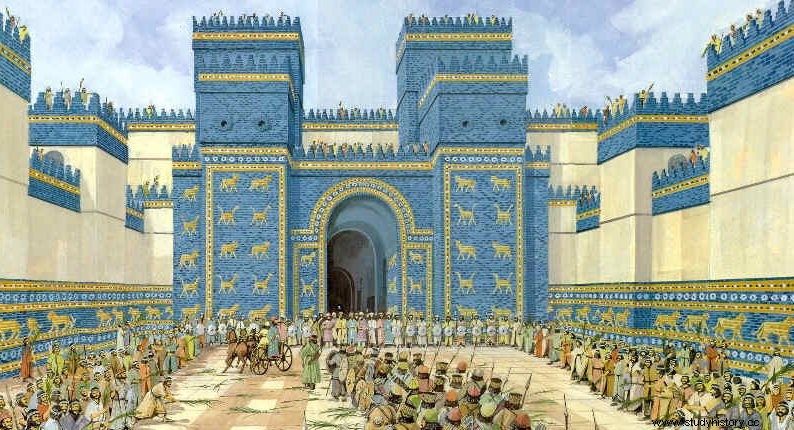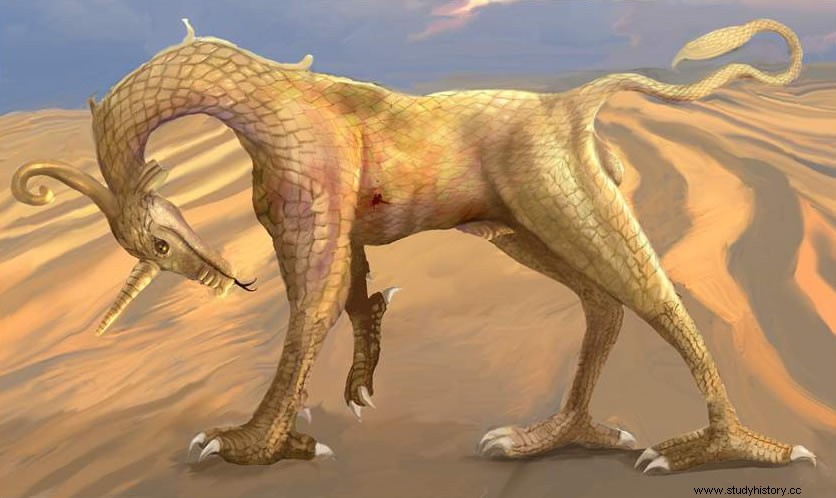It is well known that the ancients were pleased that their gods had many adventures. It is already known that the people like to brag about powerful gods. The god Marduk , patron of Babylon, could not be less. We are not going to deal here with his numerous escapades, which led him to become a legend in mythology, but with the fact that he was accompanied by a beautiful pet, which helped him on several occasions to get out of trouble. As Disney did not exist in those days, the Mesopotamians preferred a terrible companion instead of a secondary comic, so said mascot was a dragon. The dragon Mushushu.
What was good old Mushushu like? We find the clue in the Pergamon Museum in Berlin, where one of the most beautiful objects that this area of the world produced and that has survived to this day is exhibited. In one of the rooms, the impressive and wonderful Ishtar Gate is carefully reconstructed. of Babylon. Among its blue glazed bricks, reliefs of animals stand out, especially lions, and you can also see the figure of our dragon, although it does not look much like the image we usually have of one today.

Isthar Gate
Each people of the Earth has represented the dragons following their own rules of imagery. Mushushu it has scales on its skin, hind legs of an eagle, front legs of a lion, a long and thin tail, a long and thin neck, a serpent's tongue and a crest of uncertain origin in which some want to see horns. For the Mesopotamians, dragons had to have something of the ophidium, perhaps because of the danger posed by snakes in that area of the world. Mushushu , in fact, translated from Akkadian means “fierce serpent ”. Of all the dragons of Babylon, Mushushu He was the most original and the one who had the most adventures. Our little animal was not only involved in several fights accompanying the god Marduk , but it is thought that over the centuries it gave rise to the Greek myth of the Hydra. There was also a walk through the Bible, which in a certain way is the who's who of that area of the world, and appears in some passages from the Book of Daniel, although some Protestant churches consider these pieces to be apocryphal.

Mushushu
But perhaps the most unique fact in the history of this mythical animal is that the very discoverer of the Ishtar Gate, the archaeologist Robert Koldewey , considered that he had had a real existence. The reason why he thought this is that several real animals are represented on the door, and Mushushu would therefore be the only imaginary one, which made him unique in the eyes of the historian. In fact, it is the only mythical Mesopotamian animal that, apparently, over the centuries has not changed its image or evolved in the slightest, always remaining the same in the different artistic representations that have been preserved. All this made Koldewey believe that it was an animal taken from real life, and that it had lived with the Akkadians, the Assyrians and, possibly, even with the Babylonians, having become extinct for unknown reasons. As if that were not enough, that idea was reinforced by the biblical passages in which the archaeologist believed at face value as the devout Christian that he was. Finally and, after breaking his head a lot, because the eagle's hind legs dismantled all the schemes, he even ventured that Mushushu It would have been a close relative of the iguanodont dinosaurs whose image was, at that time, the closest to our dragon. But apart from the artistic reliefs, he never found a single bone, scale, claw, or any remains of the supposed animal.
It is evident that it never existed, and that it would have been considerably more dangerous than the iguanodons with which Koldewey he wanted to relate it. But to be one of the most photogenic mythical animals of Mesopotamian mythology, and not have the Disney writers behind, it did not go badly for him, and he achieved an immortality that other secondary actors already wanted. And, after all, there is nothing wrong with ending up being the dimension of a legend.
Contributed by Joshua BedwyR author of In a Dark Blue World
